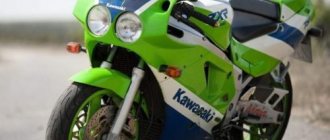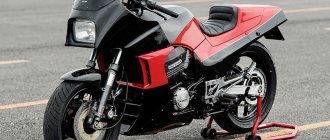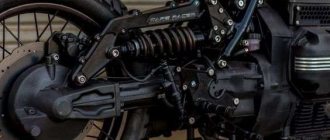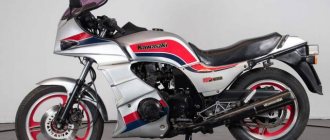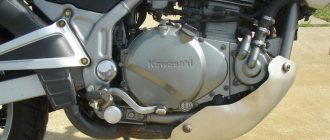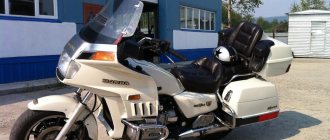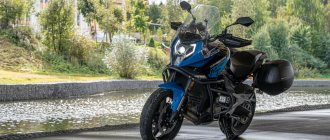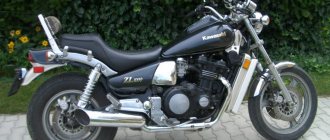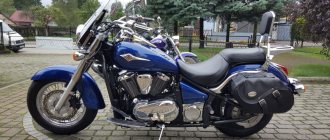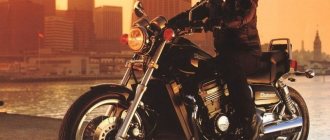Japanese motorcyclesKawasaki motorcycles
If your life is boring and you have an uncontrollable desire to get new sensations, then you can get a new two-wheeled friend.
After all, with its help, adrenaline is guaranteed, and speed will become your middle name .
But besides this, driving a motorcycle places great responsibility on the shoulders of its owner.
After all, this type of transport is much more dangerous than a regular car, and therefore the obligations are much higher.
An excellent option in this case would be the Japanese model of the Kawasaki ZZR motorcycle, which has already captivated many people thanks to its sporty orientation, streamlining and even some aggressiveness.
Engine
The engine of the ZZR 400 is very similar to the engine of the ZZR 600. Only the intake system and volume differ. By type it is an in-line, four-stroke and four-cylinder unit. Its working volume is 399 cm³.
There are 4 valves per cylinder, and the engine is liquid cooled. The compression ratio of the engine is 11.2:1. The fuel supply system is carburetor. The ignition type of the Kawasaki ZZR 400 is transistor.
Maximum engine characteristics of the model: at 9000 rpm, a torque of 37 Nm is achieved; at 11,000 rpm the power is 53 horsepower. Speed indicators are quite consistent: the bike accelerates to 100 km/h in 4.7 seconds; its maximum speed reaches 180 km/h.
Review of the Kawasaki ZZR 400 (ZX400K, ZX400N) motorcycle
Yes, the motor is a bit heavy, but 197 kg of dry weight still makes itself felt. having traveled 1800 km. In the first two weeks the clutch cable broke, bought for 900 rubles. I installed it the next day and that was the end of the damage. (I hope for a long time) I ran out of gas a couple of times, switched to reserve and couldn’t start it for a long time. and noticed that if the fuel level needle is in the red zone, it may not start (when it’s hot), then it starts. Consumption in the city is approximately 6.8-7.0 liters per hundred. I fill it with A-95. Accelerates to the cut-off speed of 170 km/h easily without straining. At 140, a slight vibration and swaying begins (doesn’t make you sick or sick;) Wind protection is only when you bend down a little, since my height is 186 cm and my arms are long, so the windage is large (up to 120 is normal, then it’s a bit heavy). The sound is that there is only one direct flow pipe. The noise was annoying at first, then I realized the advantages of this in traffic. A little heavy for the city, especially in traffic jams and with a passenger. There are no problems with the second gear (it seems like this problem was eliminated in the second gear). Of the minuses, it is also the low ground clearance when driving over recumbents and is hit by the exhaust pipe (if with a passenger).
Based on the landing, I can’t say that it is comfortable after 200 km. the fifth fulcrum begins to itch. Before and at first, my hands (especially the right one) became very numb after 30-40 minutes of driving. Now it seems like nothing. Breakdowns: except for the cable, the battery died, it’s my fault when I closed the steering wheel, there is a position at the extreme end where the rear marker turns on (I don’t know why), so out of ignorance I installed the battery. I recharged it and it seemed like ugh ugh ok 1000 km ago I punched the rear wheel after carefully studying it I realized there was no point in repairing it (it was frayed, the threads were very visible I decided to replace it with 5700 Dunlop, 1400 replacement in the Kava center (it was possible to look cheaper, I didn’t bother. I removed the lower plastic (plow) since I was screwed, I drive like this (I found it for 3,000 rubles. It’s not the original, I need to go and pick it up (it doesn’t affect the speed). 50 km ago I changed the front pads, price 2,400 set for 2 discs. I replaced it myself in 10 minutes (they change quite easily). I never found a mount for the case, but a universal one costs about 5000. I made it myself at a cost of 600 rubles. The case is very convenient.
1. How long have you had a motorcycle? — Since April 2012
2. How did he get to you? By what criteria did you choose? “It was a choice without a choice.” Back in 2002 I saw it in some movie...since then I knew in advance which motorcycle I would have first. And no amount of persuasion regarding the Honda SB, Lomuchesk Zizers could convince me. Actually, the best friend mocked sarcastically. A friend at the liter sbih said that a Kawasaki does not count as a motorcycle. Familiar mechanics said that there are no models of motorcycles worse than the Zizer. But nothing helped... in April he was the first motorcycle that I watched, and my heart immediately decided everything for me.
3. Strengths, advantages? — The main advantage for me is the ease of landing. Even after 8 hours behind the wheel you don’t get tired, and the long seat allows you to change your body position during the trip. Due to the weight and base, it stands like a glove on the highway and the side wind with oncoming trucks is not old, but not so much that you feel like a cow in city traffic. The dynamics are quite enough for ONE person.
4. Weaknesses, disadvantages? “There’s not enough power for two.” Because of this, you begin to feel not entirely comfortable.
5. What do you miss about it? — Speakers when driving together.
6. What do you use it for most often (long-distance travel, trips around the city, etc.) - around the city and the Region in the area of 300 km. I thought about going to Crimea in September, but my bosses didn’t let me go on vacation.
7. How often did you have to repair it? — Thank God there were no repairs. I don’t classify replacing consumables as such.
8. What are the most common faults? — Because of the rain, you have to lubricate the chain often. But what can you do...climate.
9. Try to compare with other models that you have used. - Well, I didn’t use any of my classmates. If you compare it with a razor, it is sooo slow and sooo convenient, after that I realized that sport is not my thing. I can’t sit like that, and I need to shoot on the track, not in the city. I won’t compare it with a golda... You can compare a liter one with a sieve, but it won’t be the same either. The urban neoclassical zetka, with all its pros and cons, is at least two and a half times more powerful. But it feels as if you are hugging a moped with your legs. It's very narrow.
10. Are you going to change and for what? For what reason? — To be frank, I don’t know. The deuce says that I need to take the golda, but I don’t want to yet... it’s too early for me in age. But even with this, it’s hard to ride with two people, the dynamics are sorely lacking. I don’t know what to take instead of zzr. It would be nice to add some horses to it (at least the same amount), change the seat (the deuce sometimes complains) and update the design a little. Still, it is slowly becoming outdated, there is no escape from it.
For what reason? — To be frank, I don’t know. The deuce says that I need to take the golda, but I don’t want to yet... it’s too early for me in age. But even with this, it’s hard to ride with two people, the dynamics are sorely lacking. I don’t know what to take instead of zzr. It would be nice to add some horses to it (at least the same amount), change the seat (the deuce sometimes complains) and update the design a little. Still, it is slowly becoming outdated, there is no escape from it.
11. What else can you say? — An ideal motorcycle for a beginner who has the gray matter to understand the true purpose of this motorcycle. The meaning of which is daily movement from one point to another at a speed slightly exceeding the general speed of the flow. It doesn’t give adrenaline, although maybe I don’t drive like that.
I’ll also write about my four hundred. This is my second year of owning a motorcycle. I first saw it when they were looking for a motorcycle for my friend, he got sick with motorcycling and really wanted an inexpensive, but beautiful bike, for starters.
After much searching and torment, a 1992 Kawasaki ZZR 400, i.e. the first model, was found. The condition was close to perfect, so they took it without thinking. Subsequently, my immersion in motorcycling stopped there for about one year, until the moment when the same friend suggested that I try to ride. After that, I got hooked on motorcycles.
A little thought and a friend’s zizer was purchased, on which I have already skated 2 seasons with great joy. I liked the motorcycle first of all for its... Chicness, no matter what they say, but the appearance still attracts close attention from people, and the frame from the 600 adds solidity and mass appeal. The second criterion was comfort; driving around the city or out of town is always a pleasure, there is no back or arm fatigue. I really liked the reliability, in two seasons, the only breakdowns that happened were the replacement of the armored wires, the temperature sensor and the RRK, the latter, however, is a completely expected disease.
Disadvantages...for me there are none at all. I haven’t perceived a noisy box as a drawback for a long time, I’ve gotten used to it. I generally like a calm, measured ride, so I don’t feel any lack of traction or horses at all; on the road I ride mostly in traffic, and I practically don’t ride between the rows, which often causes puzzled looks from motorcyclists passing by along the markings or in the aisles. Therefore, there is no lack of controllability either. It’s even nice to stand in a traffic jam, when in the next car there is a cheerful face of a child, happily pointing his finger at the glass and shouting to dad: look at the motorcycle =)) The only problem was overheating in the city cycle. But this problem was quickly solved by installing a button to force the cooler to turn on.
I can only compare it with the motorcycles that my friends had: Yamaha V-Max, Kava Zizer 1200, piano, Sibiha... Yes, my four hundred is inferior in dynamics to the Max, the older brother 1200 and even the VTEK Sibiha, it is inferior in comfort to the piano... but to me I like the zizer and exactly 400 nt no matter what! I love my horse and have no plans to change it for anything yet. Therefore, I hope that after my chaotic description, someone will also want to buy an old four hundred in the first body =)
Dimensions and weight
The weight of the car without fuel reaches 197 kg. The bike is 2070 mm long, 1175 mm high, and 695 mm wide. The wheelbase dimensions are 1430 mm, while the seat height is 780 mm. The fuel tank capacity is 17 liters, which is quite good considering fuel consumption. 100 km of road can consume from 5 to 8 liters of gasoline.
015_moto_0911_048
Yamaha XTZ660 Ténéré: touring enduro, 1991–1997, 660 cm³, 46 hp, 195 kg, RUB 100,000–160,000. Yamaha XTZ660 Ténéré: touring enduro, 1991–1997, 660 cm³, 46 hp, 195 kg, RUB 100,000–160,000.
| Estimated cost of spare parts for Kawasaki KLE400/500 | ||
| Name | Original spare parts, rub. | Non-original spare parts, rub. |
| Safety bars | — | from 135 Euro (SW-Motech) |
| Reinforced brake hose (set) | — | 1900 (Venhill) |
| Brake pads (set) | 8100 | 2400 (CL Brakes) |
| Oil filter | 465 | 320 (Hiflo) |
| Spare parts, mostly available in stock. | ||
| Spare parts, mainly imported to order. |
The motorcycle for the shooting was provided by the Drivebike motorcycle dealership.
Atypical hybrid: Kawasaki KLE500
Chassis and brakes
The motorcycle has a diagonal aluminum frame. The design is very typical for sports-tourist models: its streamlined shape immediately speaks of sportiness, while the size leaves no doubt about its tourist purpose.
The steering wheel is quite comfortable, and in size it corresponds to the average in the class. In terms of design, it is unremarkable. The appearance of alloy wheels is very simple, but at the same time, aesthetically pleasing and consistent with the image of a modern bike.
The pendulum suspension at the rear is equipped with a monoshock absorber. Its stroke is 130 mm. At the front, the suspension is provided by a telescopic fork with dimensions of 41 mm, the travel of which is also 130 mm. The rear brake is a 240 mm disc with a two-piston caliper. At the front there are two discs, 300 mm in size. They are equipped with four-piston calipers.
009_moto_0211_040
The same problem can occur in the first generation. But here the airbox itself is visible to the naked eye, which can also “leak” along the seams. The same problem can occur in the first generation. But here the airbox itself is visible to the naked eye, which can also “leak” along the seams.
(-) Another possible cause of “floating” idle is a malfunction of the relay regulator. Low voltage confuses the ignition control unit. True, this “jamb” may not come out immediately, but after the battery runs out without proper charging (usually after half an hour or an hour of engine operation, and this is immediately visible from the dim light of the headlight). The relay itself, as a rule, “gives up” when using a faulty battery. The operation of the charging system is checked simply: at engine speeds above 4000, the voltage at the battery terminals must be at least 14.5 V.
History of changes
During its existence, the Kawasaki ZR 400 went through several stages:
- 1990 – start of production and sales, first generation;
- 1993 – second generation;
- 1995 – minor changes in the ignition system, as well as in the electrics;
- 1997 – dashboard updates;
- 1998 – now has fork protection;
- 2007 is the last year of production.
The ZZR 400 motorcycle from the legendary concern will long remain in the memory of connoisseurs of the class of sports and touring bikes.
